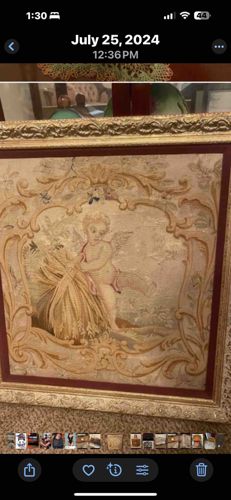
Framed Neoclassical Style Putti and Wheat Sheaf Tapestry
This item is a framed tapestry, likely a textile wall hanging, featuring a charming Neoclassical or Rococo-inspired scene. The central motif depicts a putto, or cherub, with wings, embracing a large sheaf of wheat. The putto has fair skin and light, curly hair, rendered with delicate shading to suggest three-dimensionality. Its wings are visible, contributing to the angelic or mythological theme. The background behind the putto is a muted landscape with faint trees or foliage, rendered in soft greens and creams, suggesting a pastoral setting. The central image is framed by an elaborate, highly decorative border woven directly into the tapestry. This border features intricate scrolling acanthus leaves, garlands, and possibly floral elements in tones of gold, beige, and light brown against a slightly darker background, creating a rich, opulent frame. Small, subtle details resembling butterflies or insects are visible within this decorative border. The overall color palette of the tapestry is subdued, dominated by creams, beiges, muted golds, and soft greens, giving it an aged and classic appearance. The tapestry appears to be machine-woven, given the uniformity of the weave visible in the details, though it aims to mimic the intricate appearance of hand-woven pieces. It is mounted within a substantial, ornate wooden frame. The frame itself is gilded or painted in a gold finish, featuring raised, molded, and carved decorative elements such as acanthus leaves and scrolls, consistent with an antique or vintage aesthetic. A dark red or burgundy mat or inner frame section separates the tapestry from the outer gold frame, providing a contrasting border. The visible condition suggests some age, with a possible presence of dust or light discoloration consistent with textiles that have been displayed for a period. There are no immediately obvious tears or significant damage visible, but a closer inspection would be required to ascertain its full condition. This piece likely dates from the late 19th to early 20th century, or perhaps a later reproduction in an antique style, drawing inspiration from classical European decorative arts.
AI-Generated Appraisal Disclaimer
Estimated Value
$300-500
Basic Information
Category
Textile Art
Appraised On
November 28, 2025
Estimated Value
$300-500
Additional Details Provided By Owner
User Provided Information
Goblin tapestry
Item Description
This item is a framed tapestry, likely a textile wall hanging, featuring a charming Neoclassical or Rococo-inspired scene. The central motif depicts a putto, or cherub, with wings, embracing a large sheaf of wheat. The putto has fair skin and light, curly hair, rendered with delicate shading to suggest three-dimensionality. Its wings are visible, contributing to the angelic or mythological theme. The background behind the putto is a muted landscape with faint trees or foliage, rendered in soft greens and creams, suggesting a pastoral setting. The central image is framed by an elaborate, highly decorative border woven directly into the tapestry. This border features intricate scrolling acanthus leaves, garlands, and possibly floral elements in tones of gold, beige, and light brown against a slightly darker background, creating a rich, opulent frame. Small, subtle details resembling butterflies or insects are visible within this decorative border. The overall color palette of the tapestry is subdued, dominated by creams, beiges, muted golds, and soft greens, giving it an aged and classic appearance. The tapestry appears to be machine-woven, given the uniformity of the weave visible in the details, though it aims to mimic the intricate appearance of hand-woven pieces. It is mounted within a substantial, ornate wooden frame. The frame itself is gilded or painted in a gold finish, featuring raised, molded, and carved decorative elements such as acanthus leaves and scrolls, consistent with an antique or vintage aesthetic. A dark red or burgundy mat or inner frame section separates the tapestry from the outer gold frame, providing a contrasting border. The visible condition suggests some age, with a possible presence of dust or light discoloration consistent with textiles that have been displayed for a period. There are no immediately obvious tears or significant damage visible, but a closer inspection would be required to ascertain its full condition. This piece likely dates from the late 19th to early 20th century, or perhaps a later reproduction in an antique style, drawing inspiration from classical European decorative arts.
Get Your Items Appraised
Instant estimates of your treasures with AI-powered instant appraisals